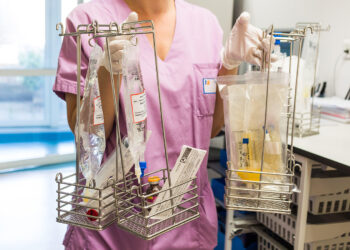[ad_1]
Real-time skin monitoring could make oral food challenges (OFCs) safer for young children with peanut allergies by reducing severe reactions, a new study found.
Researchers at the University of Michigan in Ann Arbor, Michigan, found that using transepidermal water loss (TEWL) as the criterion for stopping a food challenge resulted in significantly lower rates of anaphylaxis and epinephrine use.
The findings, which were presented at the American Academy of Allergy, Asthma & Immunology (AAAAI) 2025 Annual Meeting, suggest that TEWL monitoring may help detect allergic reactions earlier, potentially preventing mild symptoms from escalating and necessitating emergency treatment.
The randomized control trial divided 40 children between ages 6 months and 5 years with confirmed peanut allergies into two groups. The control group received standard of care, in which a test is stopped if clear signs of an allergic reaction develop. The intervention entailed using real-time TEWL monitoring to determine when to stop the challenge, or when clear signs of allergy developed, whichever occurred first.
“There was a significantly lower rate of anaphylaxis among reactors in the intervention group (63% vs 100%; P = .01),” the study authors wrote. “There was a significantly lower rate of epinephrine use among reactors in the intervention group (50% vs 86%; P = .04).”
“TEWL might be a way to detect anaphylaxis early as you are monitoring someone who is undergoing a food challenge, even before symptoms were developing in some cases,” said Cosby Stone, MD, assistant professor of medicine in the Division of Allergy, Pulmonary and Critical Care Medicine at Vanderbilt University Medical Center in Nashville, Tennessee. Stone was not involved in the study.
OFCs are considered the gold standard for diagnosing food allergies, but concerns over severe reactions limit their use.
“The person that you want to do a challenge on is someone who genuinely might not be allergic after all but needs to have that first dose in your office to be sure or to provide an extra layer of safety,” Stone said.
Allergists already have several strategies to mitigate risks when conducting food challenges, including performing appropriate risk assessments and testing beforehand, and making sure other health conditions like asthma are well controlled, he said.
“You may also do a food challenge on someone when you are going to start a treatment for their food allergy, and you need to carefully figure out the threshold of food that they can tolerate before having symptoms,” Stone said.
The TEWL approach could improve the safety and accessibility of OFCs, helping more patients receive accurate diagnoses without the heightened risk for anaphylaxis, the researchers stated in the study.
While more research is needed before TEWL monitoring becomes standard practice, Stone said, the findings are a step in the right direction.
“I don’t think that TEWL is quite ready for everyone to incorporate it into their allergy practice,” he said, “but the data from these authors were compelling enough that there will need to be a whole host of follow-on studies to confirm their findings and study this approach in other settings.”
Lara Salahi is a health journalist based in Boston.
[ad_2]
Source link : https://www.medscape.com/viewarticle/skin-monitoring-could-reduce-anaphylaxis-during-food-allergy-2025a1000608?src=rss
Author :
Publish date : 2025-03-12 11:13:00
Copyright for syndicated content belongs to the linked Source.














